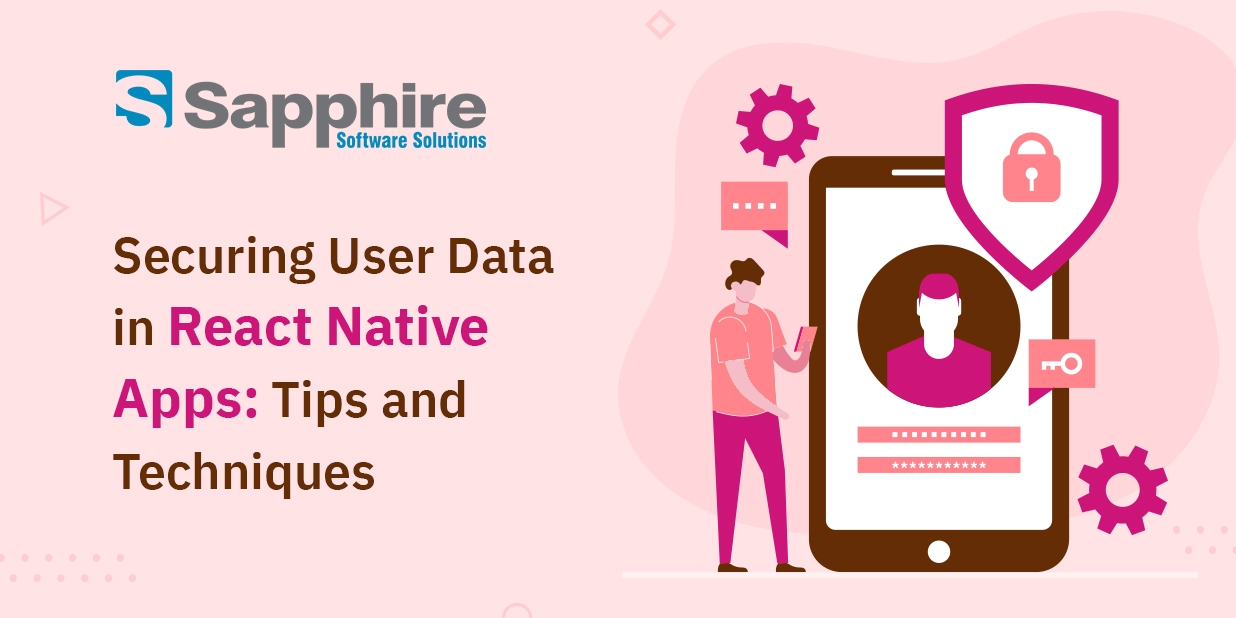In the digital age, app developers and customers worry about data security. Mobile apps, particularly React Native ones, manage sensitive user data, including financial, personal, and communication histories. Therefore, data security is essential. As a Mobile App Development Company in USA, you can count on us for securing user data in React Native apps. To safeguard user data in React Native apps, we’ll discuss some tips and techniques. In case you are not able to do it on your own, hire mobile app developers in USA now and stay safe.
1. For network communication, use HTTPS.
The foundation of data security in React Native apps is using HTTPS (Hypertext Transfer Protocol Secure) for network connection. It ensures that all data sent between your app and the server is encrypted, guarding against unwanted access, listening in on conversations, or manipulating data while in motion. HTTPS protects login passwords and personal data from eavesdroppers. Implementing this encryption protocol is essential for user data safety. Thankfully, React Native makes using HTTPS for network queries simple, and frameworks like Axios and Fetch support HTTPS by default, making it a best practice for React Native app development. If you want to learn more, contact our Mobile App Development Company in USA now!
2. User authentication should be used.
In React Native apps, user authentication is crucial to user data security. It creates a sense of trust and guarantees that only users with permission can access private features and data. When users login or register, robust authentication systems such as OAuth, OpenID Connect, or JSON Web Tokens (JWT) verify their identities. The prevention of unwanted access and impersonation depends on this procedure. Developing user registration and login procedures and password recovery tools are all part of implementing secure user authentication. Multi-factor authentication (MFA) adds security by requiring several verifications before access. User authentication is React Native apps’ initial data protection layer.
3. Discreet Storage:
Just as crucial as safeguarding data in transit is securing data at rest. Sensitive data, such as user tokens or passwords, is often stored on the device in React Native apps. Implementing safe storage procedures is crucial to preventing unwanted access to sensitive data. A sync Storage in React Native may store tiny amounts of data locally, but it’s not intended for usage in high-security circumstances. React-native-keychain and react-native-secure-storage improve encryption and security. Secure storage libraries encrypt data before saving it on the device, making it unreadable even if an attacker can access the file system. Secure storage on the user’s device protects sensitive user data, a vital aspect of your app’s data security approach.
4. Encryption of Data:
Sensitive information should be protected from unwanted access via data encryption, a critical security safeguard. It entails ciphering data into a format that can only be decoded with the correct encryption key. This ensures that it will be safe and unreadable even if data is intercepted. AES, RSA, and SSL/TLS are prominent transport encryption techniques. Data at rest is routinely encrypted using full-disk or database encryption techniques. Strong encryption protects sensitive data on servers and networks; therefore, any comprehensive security strategy must incorporate it. If you are looking to learn more about it, contact our Best Mobile App Development Company.
The process of deciding which operations users or systems are permitted to carry out inside an application or system is known as authorization. Establishing and implementing access restrictions based on roles, permissions, and rules is necessary for successful authorization implementation. This ensures that only those permitted may carry out particular tasks or access specific resources. A popular technique is role-based access control (RBAC), where users are given roles with corresponding permissions. It is essential to implement effective authorization methods to prevent unwanted access and preserve the confidentiality and integrity of data.
6. Validation and Sanitization of Input:
SQL injection, XSS, and CSRF must be prevented in applications. These issues may be prevented by validating and sanitizing input. The danger of fraudulent input is decreased by verifying and validating user inputs to ensure they adhere to anticipated forms and criteria. Cleaning and eliminating potentially dangerous characters or code from input data is known as sanitation. When carried out correctly, these procedures may significantly reduce security risks and improve an application’s overall security posture. You can Hire Mobile App Developers in USA from us to make secure and intuitive apps.
7. Rate Limiting for API:
API rate limitation limits the amount of API queries a client may perform in a given time. This safeguards server resources, inhibits abuse, and encourages fair usage. A client’s maximum number of requests per second, minute, or hour is determined by rate-limiting restrictions. Organizations may safeguard their APIs from abuse or denial-of-service attacks by introducing rate limitations, guaranteeing a reliable and timely service for all users. APIs’ security and performance fundamentally depend on correctly set rate limiting restrictions.
8. Update Dependencies Frequently:
To fix known security flaws, update your app’s dependencies often. Attackers may use outdated dependencies to their advantage. Tools like npm audit examine your project for vulnerabilities to help you find and fix security concerns. An essential step in keeping a safe React Native project is updating dependencies.
9. Monitoring and Logging:
The security architecture of your app must include logging and monitoring. The identification and reaction to security issues are aided by robust logging, which records security-related events and mistakes. Tools like Sentry and Roll bar effectively provide error monitoring and management. Set up notifications and alerts to be informed about any questionable activity, enabling prompt response when required.
10. Security on the server:
The backend of your React Native project must be protected, too. Take strong security measures to protect your server against SQL injection, XSS, and CSRF. To prevent these attacks, validate and sanitize input.
11. Security audits and penetration tests regularly:
To proactively find flaws and vulnerabilities in your software, do security audits and penetration tests regularly. These evaluations mimic actual assaults, assisting you in identifying and fixing security flaws before unscrupulous parties can take advantage of them. To maintain high security, think about working with a specialized security company or carrying out these checks internally.
12. Uploading Secure Files:
If your app enables users to upload files, put substantial restrictions to ensure the data are secure. Limit the sorts of allowed files, check the contents, and store the files securely. Consider using malware scans to find and remove potentially dangerous files and improve the security of your data transfer and storage.
13. Managing mistakes gracefully:
Error messages shouldn’t provide sensitive information since attackers may find them helpful. Instead, provide users with general error messages and record specific issue information on the server for troubleshooting. This strategy reduces the possibility of accidentally revealing sensitive information.
14. Update Security Documentation:
Keep up-to-date incident response plans, threat models, and architectural diagrams in your app’s security documentation. Make sure that the members of your development team are knowledgeable on security best practices and know how to react to security problems. This documentation should be updated often to prepare your team for security concerns.
Check Out: Why react native frameworks are the best choice for mobile apps
15. Continually Inform Your Team:
Updating the most recent threats and vulnerabilities is essential since security is a continuous effort. Inform your development team regularly about new security threats and recommended procedures. Training and awareness programs ensure that your staff can stay alert and respond to changing security risks. Overall, securing user data in React Native apps needs a combination of best practices and techniques across storage, server-side security, network connection, and user authentication. These tips and techniques may significantly reduce data breaches and protect user privacy when you Mobile App Development Company in USA.
Security is an ongoing endeavour, and being current on threats and vulnerabilities is crucial in this dynamic world. If you are interested in services related to React Native, our React native app development company in USA is here to help you. You can also hire mobile app developers in USA to create custom mobile apps.
FAQs:
What is the advantage of React Native app?
With React Native, developers can easily pick up where they left off by accessing the code of other developers.
What is the difference between React and React Native apps?
While React Native leverages Native API to render components for mobile applications, React.js renders browser code using a virtual DOM.






































